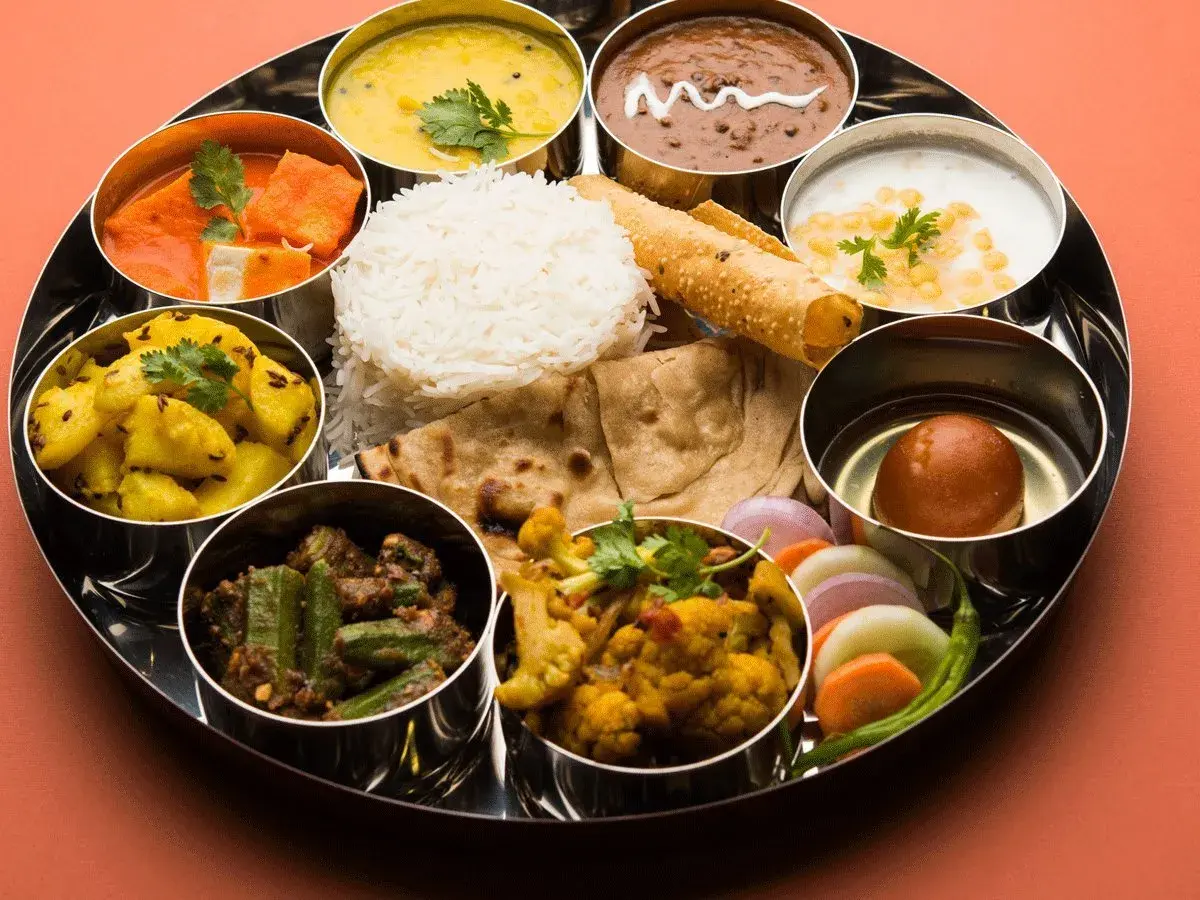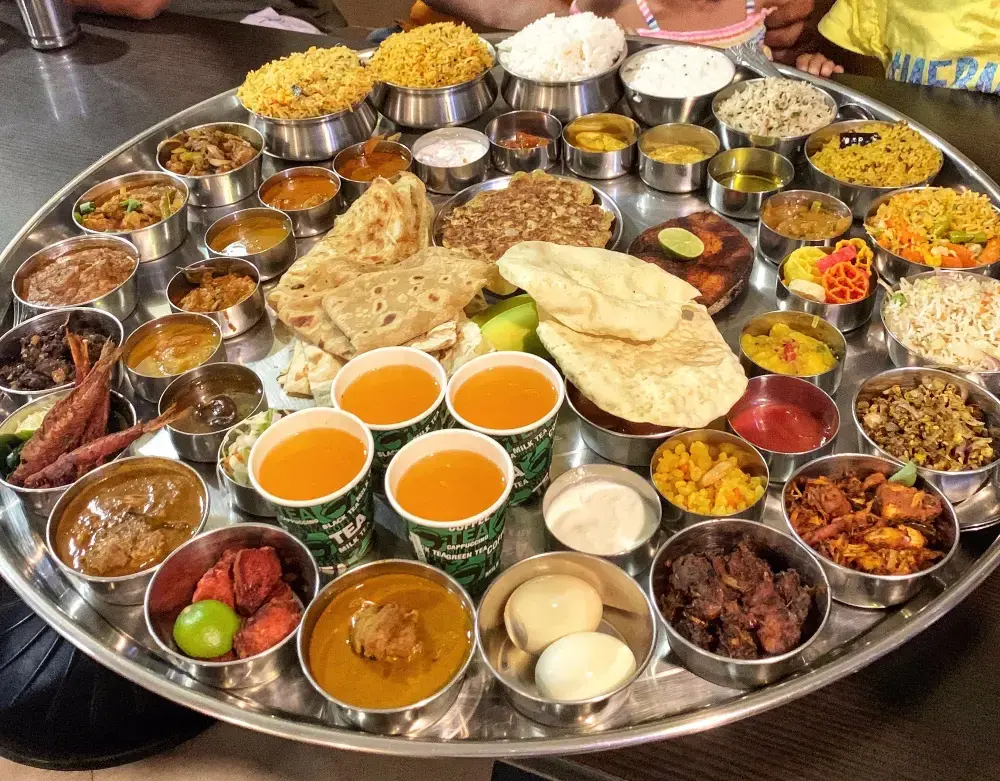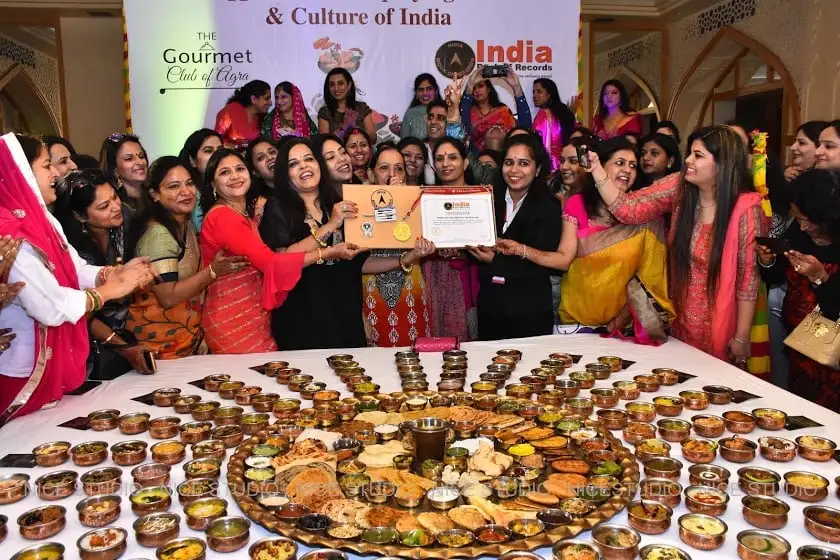
Indian thali is not just a meal but a hefty bucket of flavors, ethnicity, and culture. It is a dish combination that will take you through India’s subcontinental platter. The traditional Indian thali meal is a massive plate of numerous foods that give you a full, flavoring, and heavenly experience in particular. Indian subcontinent provides a regional take on this dish on its differentiation.
The Concept of the Thali
A thali, which is the Hindi word for “plate,” is essentially a complete meal that is served on a round metal plate or a banana leaf, with small bowls of various dishes arranged around a central dollop of rice or the handful of roti on the thali’s center. The thali concept revolves around a well-balanced meal consisting of a variety of dishes with flavor contrasts and multiple textures in such a way that you get to taste an assortment of items – sweet, sour, spicy, and salty.
In my opinion, the Indian form of eating not only represents the overflowing of offerings, but also the abiding hospitality that is so deeply ingrained in our culture. Custom In addition to offering a variety of flavors, the thali also offers a balanced meal on a nutritional basis. By providing grains, pulses, vegetables, dairy, and desserts, thalis cater to different needs and ensure that everyone who picks at the plate leaves feeling fed. As one moves from one region to another in this rich country, the traditional structure and its contents can vary widely, making this culinary exploration a fascinating one.

Structure of an Indian Thali
An Indian thali is typically organized in a way that represents harmony in flavor and nutrition. Here’s a breakdown of the key components:
- Staples:
- Rice: Typically plain steamed rice or a flavored version like pulao or biryani. Rice is a primary staple in South India, Bengal, and the eastern states, providing a neutral base for the rich curries and gravies.
- Roti/Chapati: A type of Indian flatbread made of whole wheat flour. It is more prevalent in the northern and western regions and pairs well with the assortment of curries.
- Curries and Lentils:
- Dal: A lentil curry, like dal tadka or dal makhani, is a staple in every thali. It provides the much-needed protein, especially for vegetarians.
- Vegetable Curry: Seasonal vegetables cooked in a flavorful sauce, such as aloo gobi or baingan bharta, offer a variety of flavors and nutrients.
- Non-Vegetarian Curry: (In non-vegetarian thalis) Chicken, mutton, or fish curry provides additional protein and flavor variety.
- Accompaniments:
- Raita: Yogurt mixed with vegetables or fruit, seasoned with spices, provides a cooling effect and contrasts the spicy dishes.
- Pickles: A variety of pickles like mango, lime, or chili to add a tangy kick.
- Chutney: Spicy, sweet, or sour chutneys made from mint, coconut, tamarind, or other ingredients enhance the flavor profile.
- Papad: Thin, crisp wafer made from lentil flour adds a crunchy texture.
- Fried Snacks:
- Pakora: Fritters made from vegetables, paneer, or lentils offer a crunchy texture.
- Samosa: Deep-fried pastry with a spiced filling serves as a popular starter.
Regional Varieties of Indian Thali
India’s diverse culture means that the thali varies greatly from region to region. Each region offers its unique combination of dishes and flavors, and the regional thalis showcase the incredible diversity of Indian cuisine.
1. North Indian Thali:
The North Indian thali is characterized by its rich and flavorful gravies, which are best complemented by rice, roti, or naan. The northern regions are known for their love of dairy, leading to the widespread use of ghee, yogurt, and paneer.
- Staples: Roti, rice, naan.
- Dal/Lentils: Dal makhani, chana masala.
- Vegetables: Aloo gobi, paneer butter masala, baingan bharta.
- Meat/Fish: Butter chicken, mutton rogan josh.
- Desserts: Gulab jamun, kheer.
- Accompaniments: Raita, pickle, papad.
2. South Indian Thali:
South Indian cuisine is dominated by rice-based dishes and a plethora of coconut-based gravies. The traditional South Indian thali often comes on a banana leaf, adding a unique aroma to the danatoto meal.
- Staples: Steamed rice, dosa, idli.
- Dal/Lentils: Sambar, rasam.
- Vegetables: Avial, poriyal, kootu.
- Meat/Fish: Chettinad chicken, fish curry.
- Desserts: Payasam, kesari.
- Accompaniments: Coconut chutney, pickles, appalam.
3. Bengali Thali:
Bengali cuisine is known for its emphasis on fish, rice, and sweets. The Bengali thali often includes mustard-flavored curries and an array of delicacies that make it distinct.
- Staples: Steamed rice, luchi.
- Dal/Lentils: Moong dal, cholar dal.
- Vegetables: Aloo posto, shukto.
- Fish/Meat: Fish curry, kosha mangsho.
- Desserts: Sandesh, rasgulla, mishti doi.
- Accompaniments: Kasundi, chutney.
4. Gujarati Thali:
Gujarati cuisine is predominantly vegetarian and features a variety of sweet, sour, and spicy flavors. The Gujarati thali is known for its extensive assortment of dishes.
- Staples: Bajra roti, khichdi.
- Dal/Lentils: Gujarati dal, kadhi.
- Vegetables: Undhiyu, sev tameta nu shaak.
- Snacks: Dhokla, khandvi.
- Desserts: Shrikhand, mohanthal.
- Accompaniments: Chutneys, pickles, papad.
5. Maharashtrian Thali:
Maharashtrian cuisine blends coastal and interior influences, resulting in a diverse thali that caters to both vegetarian and non-vegetarian tastes.
- Staples: Bhakri, rice.
- Dal/Lentils: Varan, aamti.
- Vegetables: Bharli vangi, batata bhaji.
- Meat/Fish: Malvani chicken curry, fish fry.
- Desserts: Puran poli, shrikhand.
- Accompaniments: Thecha, sol kadhi.
6. Rajasthani Thali:
Rajasthan’s arid climate and rich history have shaped a cuisine that emphasizes the use of spices, dairy, and grains. The Rajasthani thali is known for its bold flavors and unique dishes.
- Staples: Bajra roti, rice.
- Dal/Lentils: Dal baati churma, panchmel dal.
- Vegetables: Gatte ki sabzi, ker sangri.
- Snacks: Mirchi vada, kachori.
- Desserts: Ghewar, malpua.
- Accompaniments: Lehsun chutney, pickles, papad.
7. Punjabi Thali:
Punjabi cuisine is known for its robust and hearty dishes. The Punjabi thali reflects the region’s rich agricultural heritage and love for dairy products.
- Staples: Makki di roti, rice, naan.
- Dal/Lentils: Dal makhani, maa di daal.
- Vegetables: Sarson da saag, paneer tikka masala.
- Meat/Fish: Amritsari fish, chicken tikka.
- Desserts: Phirni, gajar ka halwa.
- Accompaniments: Butter, pickle, papad.

Indian thali: Significance and Etiquette
Balanced Nutrition: Thalis provide a comprehensive balance of carbohydrates, proteins, fats, and vitamins. Each regional thali, despite its variations, ensures a balanced mix of grains, legumes, vegetables, and dairy.
Cultural Significance: Thalis symbolize hospitality and are often served during festive occasions and weddings. The variety of dishes on a thali reflects abundance and the host’s willingness to provide guests with the best of everything.
Eating Etiquette:
- Begin with the starters and gradually move to main courses. Starting with appetizers helps to awaken the taste buds.
- Use fingers, traditionally, for eating; the right hand is preferred.
- Savor a little of each dish, ensuring that the flavors complement each other.
Indian thali: Preparation and Cooking Techniques
Preparing a thali is no small feat and requires careful planning and execution. The variety of dishes involved often means that different cooking techniques are used simultaneously. Here’s a glimpse of some cooking techniques:
1. Tadka/Tempering: A key step in most Indian curries involves tempering spices in hot oil or ghee to release their flavors.
2. Grilling/Tandoori: Meat, fish, and vegetables are often marinated and cooked in a tandoor (clay oven) or grilled over an open flame.
3. Deep-Frying: Snacks like pakoras, samosas, and vadas are deep-fried to achieve a crispy texture.
4. Steaming: Idlis, dhoklas, and modaks are steamed to retain their softness.
5. Baking/Roasting: Dishes like baati and bhakri require baking or roasting for a unique flavor.
Indian thali: Popular Thali Combinations
1. South Indian Sadhya:
- Staples: Steamed rice, appam.
- Vegetables: Avial, thoran, pachadi.
- Dal/Lentils: Sambar, rasam.
- Accompaniments: Pappadam, pickles, chutney.
- Desserts: Payasam, banana chips.
2. North Indian Veg Thali:
- Staples: Roti, rice, naan.
- Vegetables: Paneer tikka masala, aloo gobi.
- Dal/Lentils: Dal tadka, chana masala.
- Accompaniments: Raita, pickle, papad.
- Desserts: Gulab jamun, kheer.
3. Maharashtrian Non-Veg Thali:
- Staples: Bhakri, rice.
- Meat/Fish: Malvani chicken curry, fish fry.
- Dal/Lentils: Varan, aamti.
- Accompaniments: Sol kadhi, thecha.
- Desserts: Shrikhand, puran poli.
4. Rajasthani Thali:
- Staples: Bajra roti, rice.
- Vegetables: Gatte ki sabzi, ker sangri.
- Dal/Lentils: Dal baati churma, panchmel dal.
- Accompaniments: Lehsun chutney, pickles, papad.
- Desserts: Ghewar, malpua.

Modern Interpretations of the Indian Thali
While the traditional thali remains popular, contemporary chefs have started to offer innovative versions that appeal to modern tastes.
1. Fusion Thalis:
- Blending Indian and international flavors, these thalis include dishes like quinoa pulao, avocado raita, and tandoori tofu.
2. Themed Thalis:
- Some restaurants offer thalis based on specific festivals or regions, like the Durga Puja Thali or the Onam Sadhya.
3. Vegan and Health-Conscious Thalis:
- With growing interest in plant-based diets, vegan thalis emphasize legumes, vegetables, and dairy alternatives.
4. Mini Thalis:
- For those who want a sampling of flavors without overeating, mini thalis include a smaller selection of dishes.
Thali Etiquette and Dining Tips
1. Embrace Variety: Take a little of each dish to appreciate the contrasting flavors. Avoid focusing on just one or two items.
2. Use the Right Hand: Indian tradition emphasizes using the right hand for eating. The left hand is reserved for serving and assisting.
3. Balance Spices: Eat yogurt or raita to balance out spicy dishes and cleanse the palate.
4. Finish with a Sweet Note: Indian thalis often conclude with desserts like kheer or payasam to provide a satisfying end to the meal.
5. Respect Cultural Differences: Be mindful of regional and cultural differences in how thalis are served and eaten.
Conclusion
Thus, the Indian thali not only reflects the country’s vibrant cuisine but also symbolizes the essence of Indian cultural diversity. The thali, whether a humble vegetarian meal or a grand festive spread, is a sensory experience that encapsulates the soul of Indian food. In every morsel, one can partake of the love, tradition and unique flavors that encapsulate Indian homes. Right from the fiery gravies of Punjab to the coconut-infused curries of Kerala, the thali curates the best of Indian regional food into a single plate.
The meal more than a culinary delight; it is an ode to life. The harmony of taste, texture and fragrance present in a thali not only ensures that one savors Indian cuisine but ponders the richness of its culinary heritage. True, the meal could be eaten at a roadside dhaba, a home for a family get-together or an occasion for celebration; the Indian thali remains a symbol of the Indian love for all culinary delights. Therefore, when ends up eating your thali the next time, extend a thought of the rich cultural and gastronomical significance each dish represents.
If you enjoyed reading this article, please consider exploring our article about Oath. It’s sure to offer another fascinating insight into India’s diverse culinary landscape.







